
3troubleshootingjunos
.pdf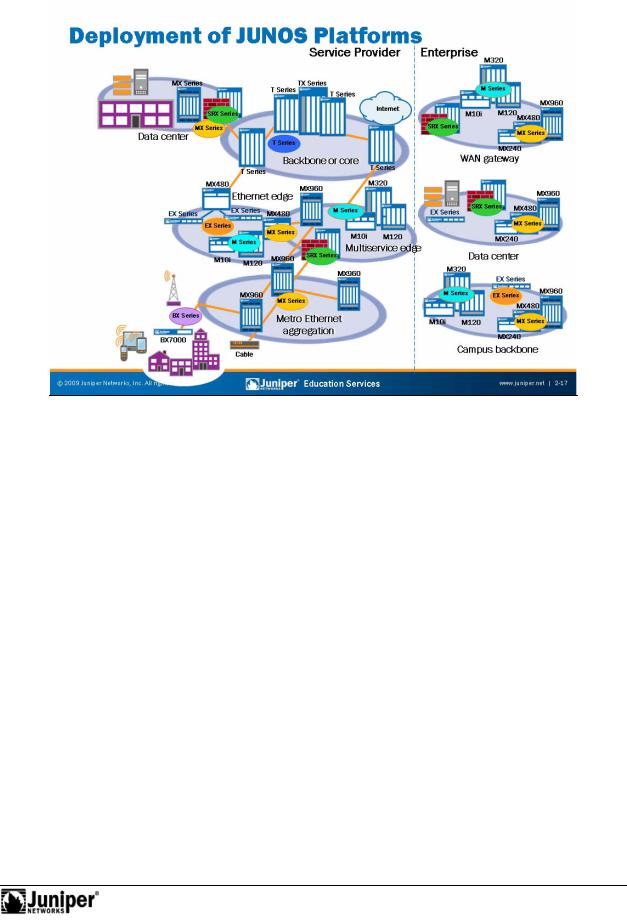
Troubleshooting JUNOS Platforms
|
|
|
Reproduction |
|
|
|
|
|
|
||
|
|
Deploym nt of JUNOS Platforms |
|||
|
|
The slide summariz s our view of all JUNOS platforms. |
|||
Not |
for |
|
|
|
|
|
|
|
|
||
Overview of JUNOS Platforms • Chapter 2–17
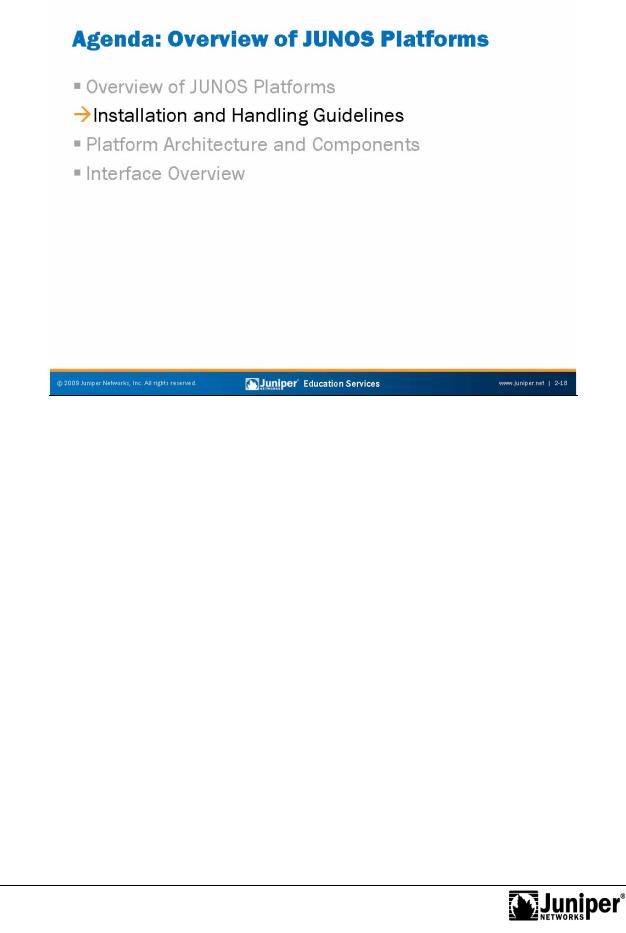
Troubleshooting JUNOS Platforms
|
|
|
Reproduction |
|
|
|
|
|
|
||
|
|
Installation and Handling Guid lines |
|||
|
|
The slide highlights the topic we discuss next. |
|||
Not |
for |
|
|
|
|
|
|
|
|
||
Chapter 2–18 • Overview of JUNOS Platforms
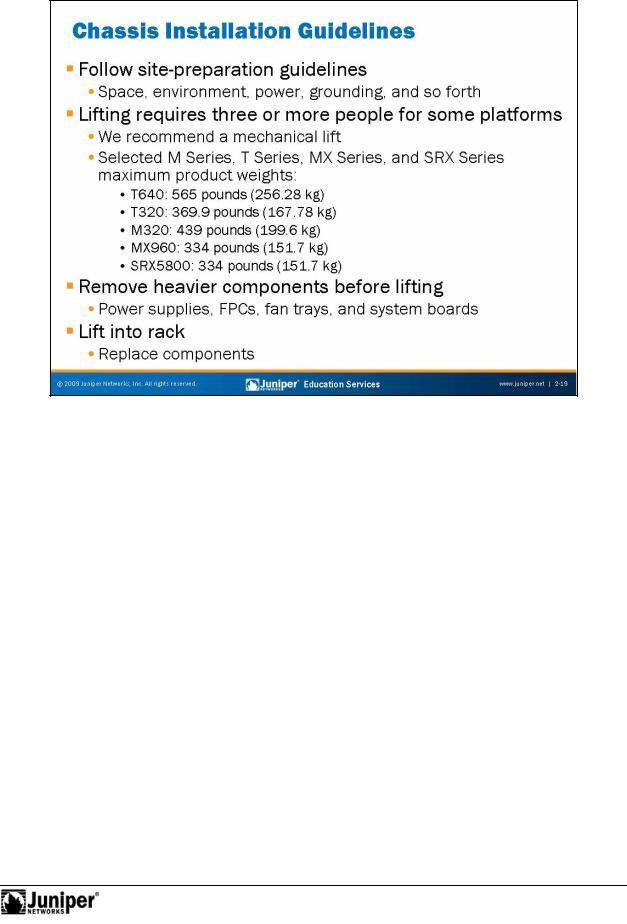
Not
Troubleshooting JUNOS Platforms
FollowReproductionSite Pr aration Guidelines
To ensure a smooth installation, each platform has an associated hardware guide that provides installation instructions. The hardware guide provides critical details such as maximum component and system power draw, system weights, and the clearances
forneeded for serviceability and proper cooling. We also provide an installation checklist m to help ensure that you are ready to press your new platform into service the day
that it a ives.
F ha dware manuals, go to: http://www.juniper.net/techpubs/hardware/index.html.
Heavy Lifting Requires More People
A Juniper Networks platform with a maximum configuration can weigh anywhere from 61 lbs (27.7 kg) for an M7i router, all the way up to 565 lbs (256.28 kg) for a T640 Core Router.
Remove the Heavier Components Before Lifting
Removing the power supplies, FPCs, fan trays, REs, and CBs can make a given platform considerably lighter. For example, a T640 chassis and midplane alone weighs only 205 pounds (93 kg). When fully loaded, the same chassis weighs 565 pounds (256 kg).
Continued on next page.
Overview of JUNOS Platforms • Chapter 2–19

Troubleshooting JUNOS Platforms
Carefully Lift Device into Rack
Use extreme care when lifting heavy platforms! We recommend a mechanical lift. Once properly secured in the rack, you should replace the components that you removed from the chassis to reduce weight.
|
for |
Reproduction |
Not |
|
|
|
|
Chapter 2–20 • Overview of JUNOS Platforms
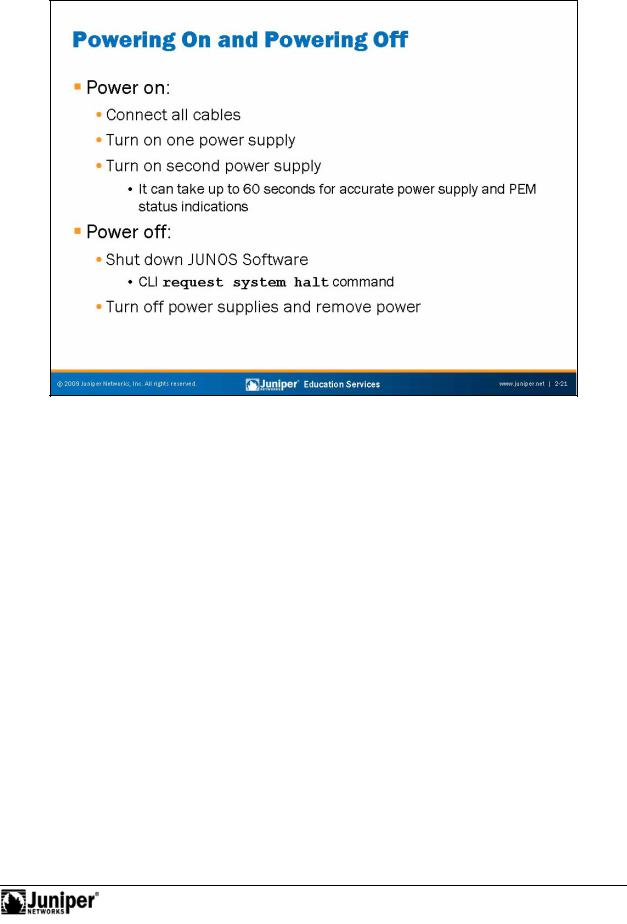
Troubleshooting JUNOS Platforms
Powering On JUNOS Platforms
|
You can equip ach vice can be equipped with two redundant, load-sharing power |
|
supplies of the same typ ; in most cases these power supplies can be either AC or DC. |
|
Be sure to connect each power source properly. For example, each power supply |
|
equi es a dedicated power source. For sites with an AC power source, each power |
|
supply has one power cord that plugs into a grounded 100–240 VAC power |
|
eceptacle. For sites with a DC power source, power normally travels around the site |
|
th ughReproductiona main conduit to frame-mounted DC power distribution panels, one of which |
|
might be located at the top of the rack where you intend to install the router. A pair of |
|
cables (–48 V and RTN) connects each DC supply to the power distribution panel. The |
|
rear enclosure has grounding studs. After connecting all cables, turn one power |
|
supply on first and then the second supply to avoid a large power spike. |
for |
|
Not |
|
Although the specifics of each power supply and PEM vary by platform, you should note that after a power supply powers on, it can take up to 60 seconds for status indicators—such as LEDs on the power supply and show chassis commands—to indicate that the power supply is functioning normally. You should ignore error indicators that appear during the first 60 seconds.
Powering Off JUNOS Platforms
You must always perform a graceful shutdown of JUNOS Software before removing power. We discuss this procedure in detail on the next slide.
Overview of JUNOS Platforms • Chapter 2–21
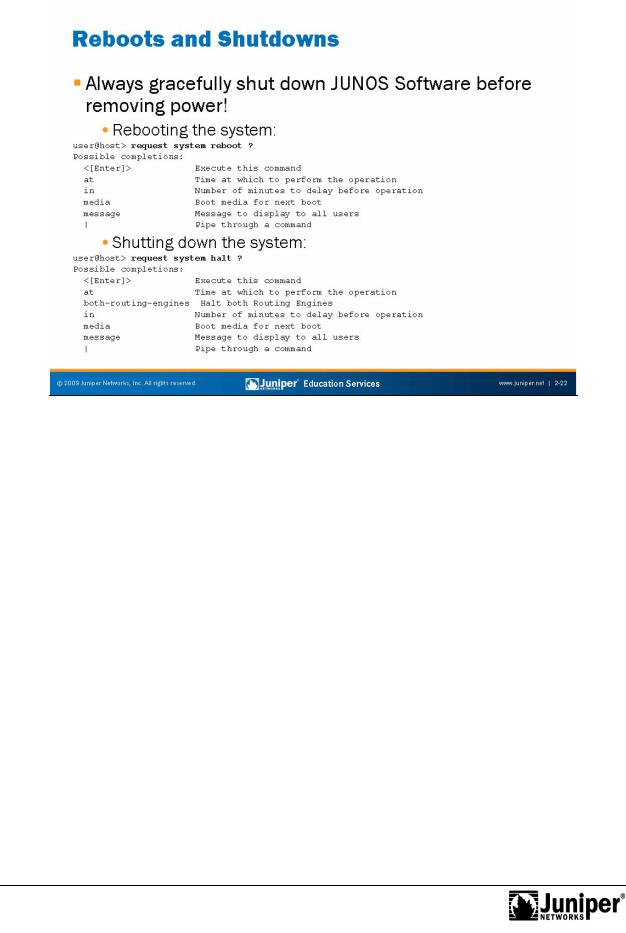
Troubleshooting JUNOS Platforms
|
|
platf ms the chassisReproductionhas a button that gracefully shuts down the RE when |
|
depressed |
|
|
|
||
|
|
Graceful Shutdowns and R booting |
||
|
|
JUNOS Software runs a multitasking, multi-user operating system based on |
||
|
|
FreeBSD. As with any UNIX syst m, you should always gracefully shut down the system |
||
|
|
before removing power (as opposed to performing an abrupt hard power off, in which |
||
|
for |
|||
|
|
you simply emove the power from the system). Failing to shut down in a graceful |
||
|
|
manner can esult in file system corruption that prolongs the next boot, and in the |
||
|
|
wo st of cases, it might actually prevent a successful boot. Note that on some |
||
|
|
3–5 sec nds. Once the system properly halts, you can safely remove power. |
||
Not |
The request system halt command gracefully stops the software and prepares |
|||
he device to shut down. Note that you must either cycle power or press the Enter key on the terminal attached to the device’s console port to effect the reboot of a device hat has executed a shutdown command.
Continued on next page.
Chapter 2–22 • Overview of JUNOS Platforms

Troubleshooting JUNOS Platforms
Graceful Shutdowns and Rebooting (contd.)
Both the reboot and shutdown command require user confirmation of the action: user@host> request system reboot
Reboot the system ? [yes,no] (no) yes
*** FINAL System shutdown message from root@host ***
System going down IMMEDIATEL
|
shutdown: [pid 15049] |
|
|
Shutdown NOW! |
|
|
The request system reboot command causes the devi o reboot. Reboot |
|
|
requests record to the system log files, which you an view with the show log |
|
|
command. The reboot command takes a variety of arg ments that you can use to |
|
|
schedule the reboot, generate a system message, or specify the media from which to |
|
|
boot. Media options include compact-flash and isk. The device always attempts to |
|
|
boot from removable media when such me ia is present and you perform a power |
|
|
cycle (cold boot). |
|
|
for |
Reproduction |
Not |
|
|
|
|
|
Overview of JUNOS Platforms • Chapter 2–23
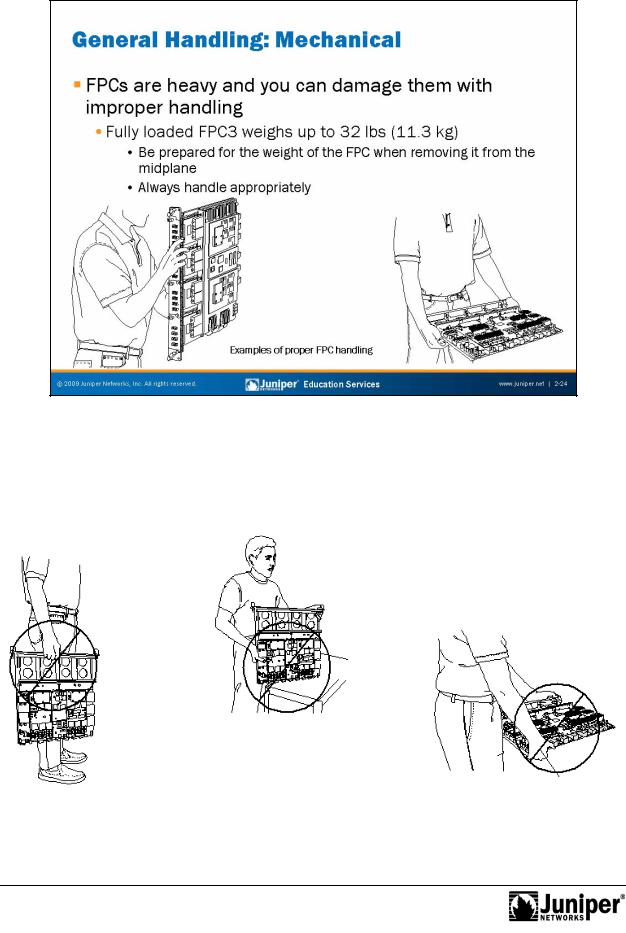
Troubleshooting JUNOS Platforms
|
|
Reproduction |
|
FPC Handling |
|
|
Some Flexible PIC Conc ntrators (FPCs) are heavy and can receive damage with |
|
|
improper handling. The following figures illustrate some common forms of FPC abuse |
|
|
that can damage your expensive hardware! |
|
Not |
for |
|
|
|
|
Chapter 2–24 • Overview of JUNOS Platforms
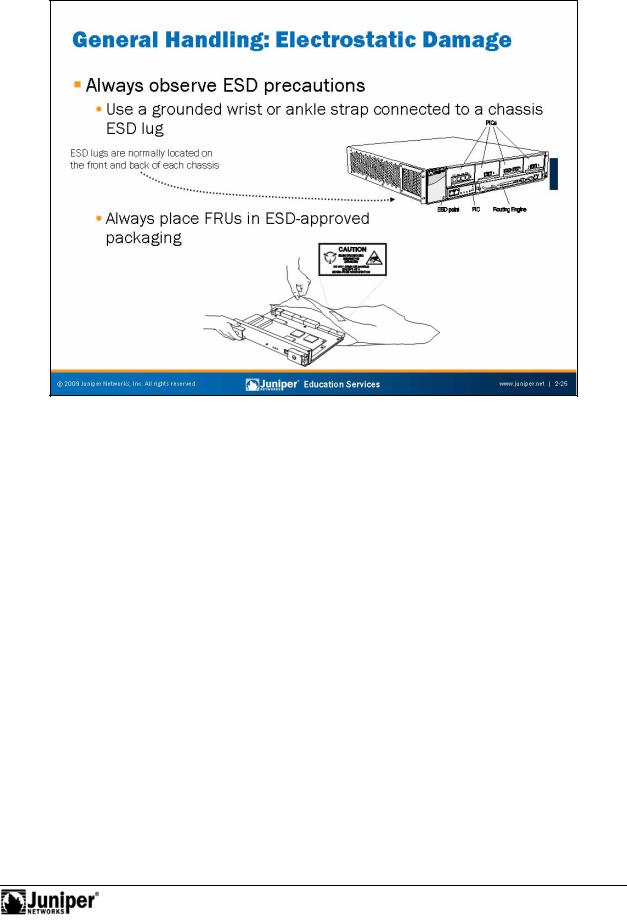
Not
Troubleshooting JUNOS Platforms
GeneralReproductionHandling: El ctrostatic Damage
The fieldplac able units (FRUs) associated with JUNOS platforms contain electrostatic discharge (ESD) sensitive parts; some components can receive damage by voltages as low as 30 V. You can easily generate potentially damaging static
voltages whenever you handle plastic or foam packing material or if you move components across plastic or carpets. To avoid unnecessary downtime and added maintenance costs, you must always observe ESD handling precautions when
handling FRUs.
F ll w these general ESD guidelines:
for |
• |
Always use an ESD wrist strap or ankle strap, and make sure that it is in |
|
direct contact with your skin. For safety, periodically check the resistance |
|
|
value of the ESD strap. The measurement should be in the range of 1 to |
|
|
10 Mega Ohms. |
|
|
• |
When handling any component that you remove from the chassis, make |
|
|
sure the equipment end of your ESD strap attaches to one of the |
|
|
electrostatic discharge points on the chassis. |
|
• |
Avoid contact between the component and your clothing. ESD voltages |
|
|
emitted from clothing can still damage components. |
|
• |
When removing or installing a component, always place it |
|
|
component-side up on an antistatic surface, in an antistatic card rack, or |
|
|
in an electrostatic bag. If you are returning a component, place it in an |
|
|
electrostatic bag before packing it. |
Overview of JUNOS Platforms • Chapter 2–25
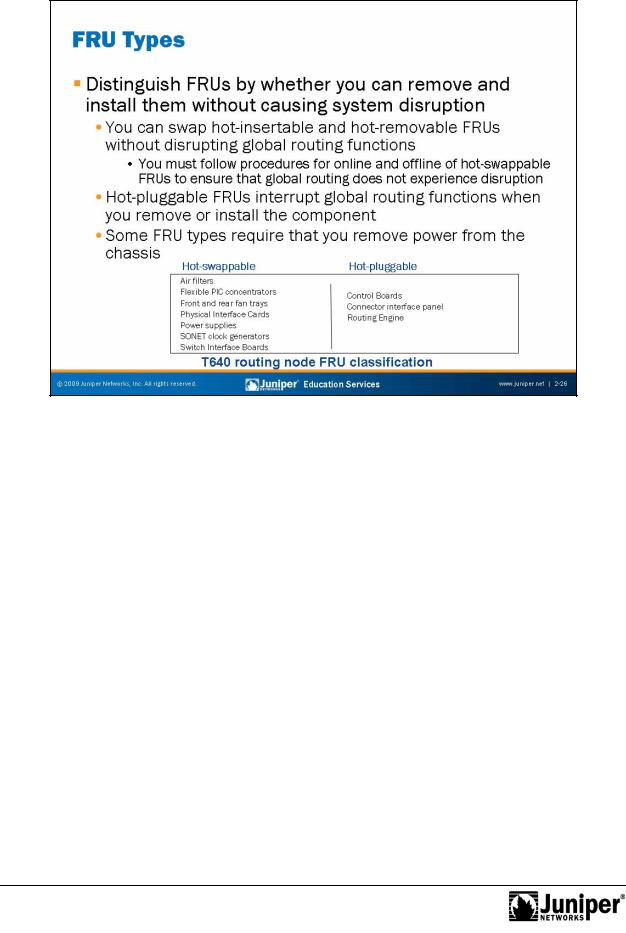
Troubleshooting JUNOS Platforms
Not
FRU Types
FRUs are platform compon nts that you ca replace at the customer site. Replacing FRUs requires minimal routing node downtime. Generally speaking, the three types of FRUs are the following:
• |
Hot-insertable and hot-removable FRUs: You can remove and replace |
|
|
these components without powering off the routing node or disrupting |
|
|
|
uting functions. We often refer to this type of FRU as being |
|
|
Reproduction |
|
hot-swappable. |
|
• |
Hot-pluggable FRUs: You can remove and replace these components |
|
|
without powering off the device, but you interrupt the routing functions of |
|
|
the system when you remove the component. |
|
• |
FRUs that require power off: In rare cases, an FRU requires that you |
|
for |
|
|
remove power from the chassis before removing or inserting it. An example of this type of FRU is the M7i and M10i platform Compact Forwarding Engine Board (CFEB) and RE. In the case of these platforms, the lack of redundant Packet Forwarding Engine (PFE) and RE capabilities made the engineering of hot-swappability for these components a nonissue.
Chapter 2–26 • Overview of JUNOS Platforms
